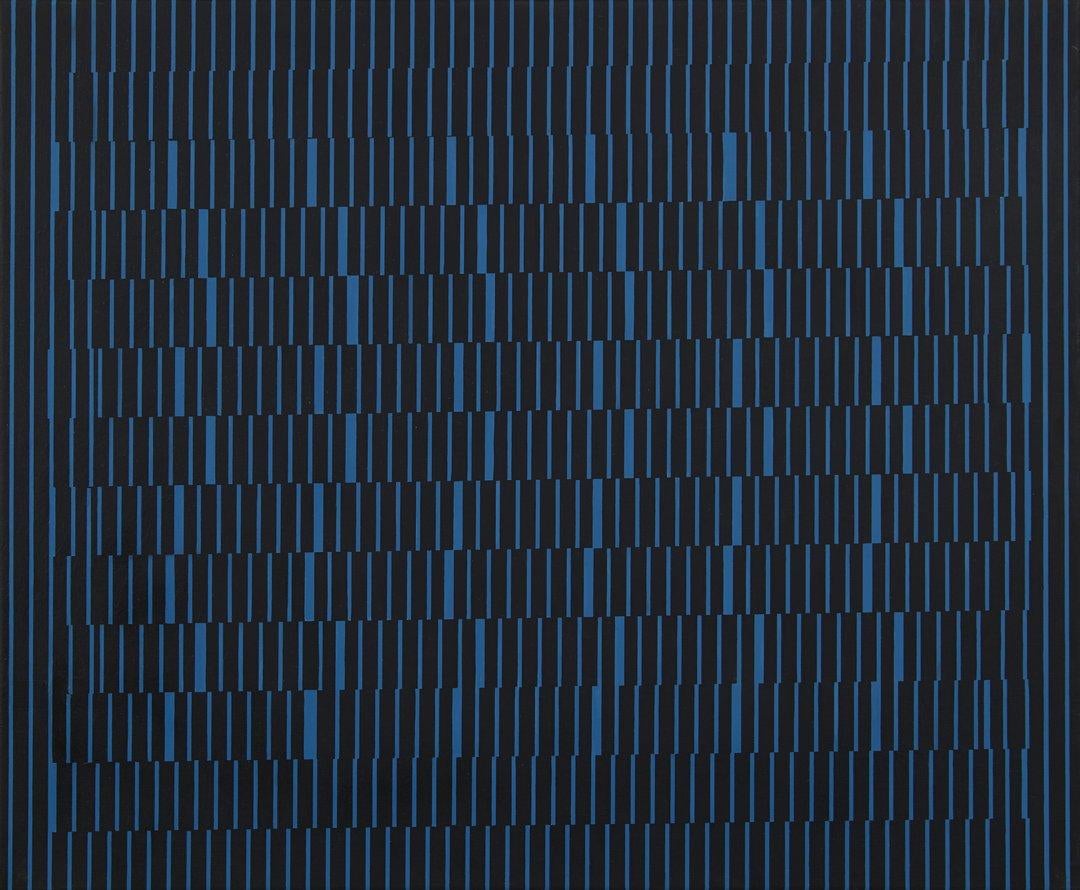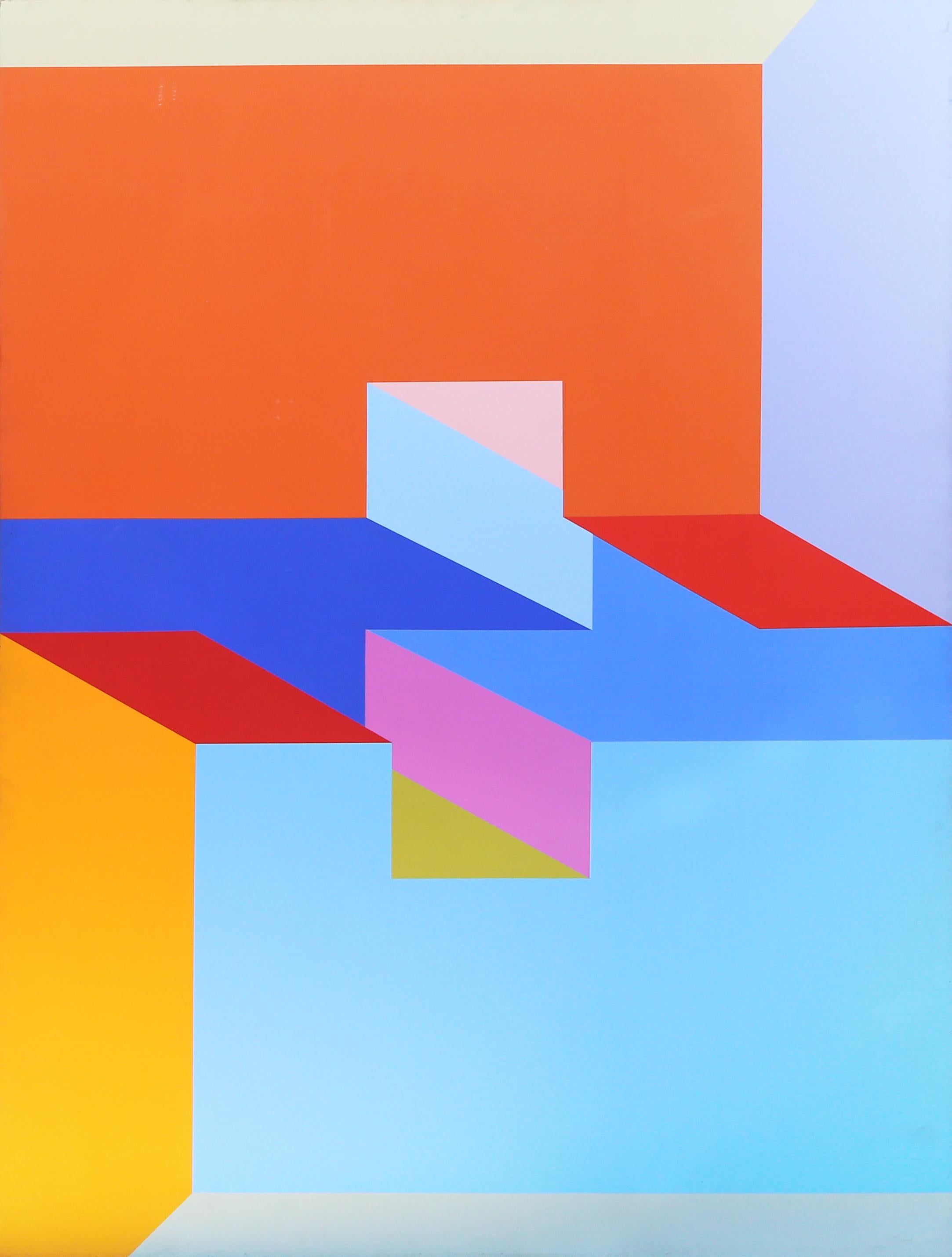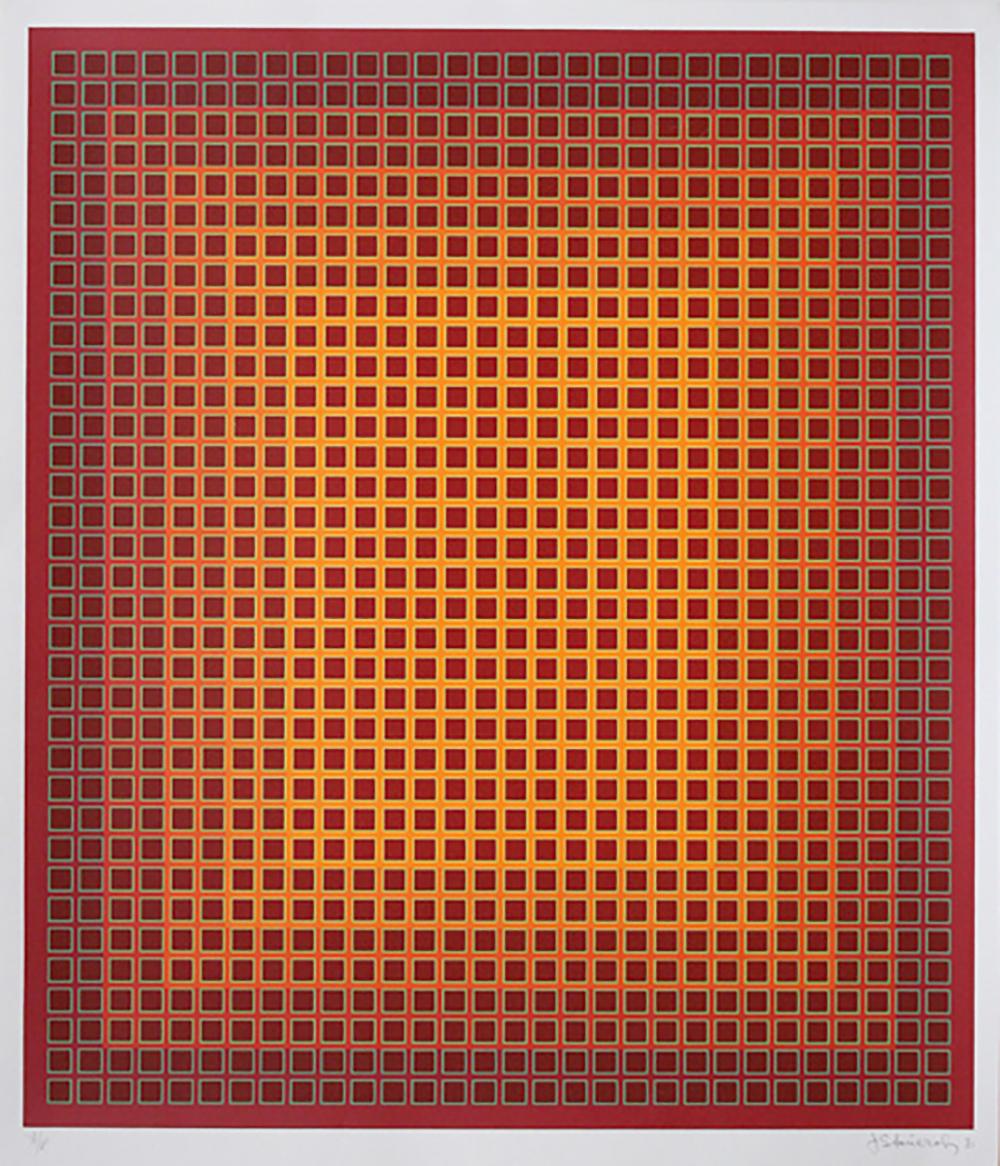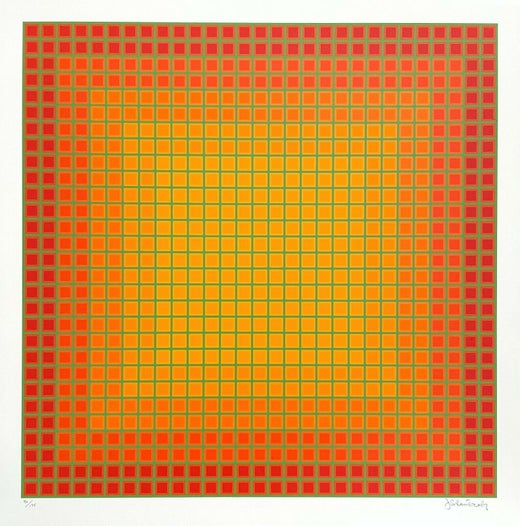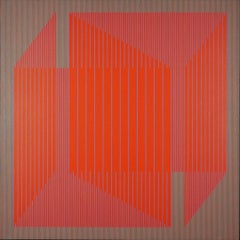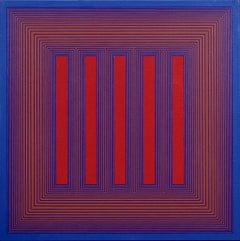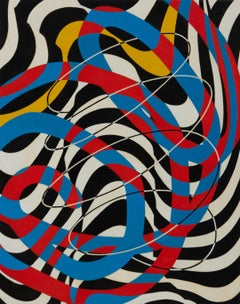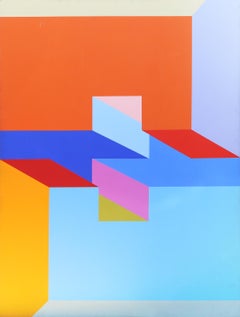Items Similar to Twist & the Rain Mid-Century OpArt Geometric Painting by Cleveland School artist
Video Loading
Want more images or videos?
Request additional images or videos from the seller
1 of 15
Julian StanczakTwist & the Rain Mid-Century OpArt Geometric Painting by Cleveland School artist1975
1975
$34,000
£25,576.15
€29,628.79
CA$47,932.96
A$53,304.65
CHF 27,977.81
MX$650,024.58
NOK 353,584.10
SEK 331,499.18
DKK 221,145.69
About the Item
Julian Stanczak (American, 1928-2017)
Twist and the Rain, 1975
acrylic on canvas
signed verso
30 x 24 inches
Julian Stanczak (American, b. November 5, 1928) was an American painter and printmaker. He was born in Borownica, Poland. When World War II broke out, he was sent to a concentration camp in Perm, Siberia. Stanczak had been right-handed before he lost the use of his right arm for good at the camp. In 1942, after successfully escaping from the camp, Stanczak joined the Polish army-in-exile in Persia but soon deserted from it. After that, the artist spent his time in a Polish refugee camp in Uganda, Africa. This was where Stanczak learned to write and paint with his left hand, and where he took his first private art lessons. He then went to Borough Polytechnic Institute in London before immigrating to the United States in 1950. Four years after his immigration, Stanczak received his BFA from the Cleveland Institute of Art. In 1956, Stanczak became a United States citizen. It was also in 1956 that he received his MFA from Yale University under the training of Josef Albers (German-born American, 1888–1976) and Conrad Marca Relli (American, 1913–2000).
Stanczak's first major solo exhibition took place at the Martha Jackson Gallery in New York. Julian Stanczak: Optical Paintings was named after the Op Art movement. His work was also exhibited in the Museum of Modern Art's 1965 exhibition The Responsive Eye . In the early 1960s, Stanczak took advantage of the use of wavy lines and contrasting colors to make the surface plane of his works more vibrant. The work Provocative Current(1965) is a notable example of this unique style. This style of painting also paved the way for more complex artworks constructed with the rigidity of different geometrical shapes; however, it maintained the softness with many levels of color transparency. Netted Green (1972) is a famous work representing this style. Stanczak uses the same form again and again to produce compositions that reflect his visual experiences. His works are mainly based on the structures of color. In the 1980s and 1990s, Stanczak kept the geometric formation in mind, and produced bright-colored or muted-colored paintings often as pieces in a series such as Soft Continuum(1981).
In 1970, Stanczak was recognized as "Outstanding American Educator" by the Educators of America. He lived and worked in Seven Hills, OH, with his wife, the sculptor Barbara M. Meerpohl before his death on March 29, 2017.
- Creator:Julian Stanczak (1928, American)
- Creation Year:1975
- Dimensions:Height: 30 in (76.2 cm)Width: 24 in (60.96 cm)
- Medium:
- Movement & Style:
- Period:
- Condition:
- Gallery Location:Beachwood, OH
- Reference Number:1stDibs: LU1768214424332
Julian Stanczak
Julian Stanczak was born in Borownica, Poland in 1928. At the beginning of World War II, Stanczak was forced into a Siberian labor camp, where he permanently lost the use of his right arm. He had been right-handed. In 1942, aged thirteen, Stanczak escaped from Siberia to join the Anders' Army in Persia. After deserting from the army, he spent his teenage years in a hut in a Polish refugee camp in Uganda. In Africa, Stanczak learned to write and paint left-handed. He then spent some years in London, before moving to the United States in 1950. He settled in Cleveland, Ohio. He became a United States citizen in 1957, taught at the Cincinnati Academy of Art for 7 years. The Op Art movement was named after his first major show, Julian Stanczak: Optical Paintings, held at the Martha Jackson Gallery in New York in 1964. His work was included in the Museum of Modern Art's 1965 exhibition The Responsive Eye. In 1966 he was named a "New Talent" by Art in America magazine. In the early 1960s he began to make the surface plane of the painting vibrate through his use of wavy lines and contrasting colors in works such as Provocative Current (1965). These paintings gave way to more complex compositions constructed with geometric rigidity yet softened with varying degrees of color transparency such as Netted Green (1972). In addition to being an artist, Stanczak was also a teacher, having worked at the Art Academy of Cincinnati from 1957–64 and as Professor of Painting, at the Cleveland Institute of Art, 1964-1995. He was named "Outstanding American Educator" by the Educators of America in 1970. (Wikipedia)
About the Seller
5.0
Platinum Seller
Premium sellers with a 4.7+ rating and 24-hour response times
Established in 1975
1stDibs seller since 2022
35 sales on 1stDibs
Typical response time: <1 hour
- ShippingRetrieving quote...Shipping from: Beachwood, OH
- Return Policy
Authenticity Guarantee
In the unlikely event there’s an issue with an item’s authenticity, contact us within 1 year for a full refund. DetailsMoney-Back Guarantee
If your item is not as described, is damaged in transit, or does not arrive, contact us within 7 days for a full refund. Details24-Hour Cancellation
You have a 24-hour grace period in which to reconsider your purchase, with no questions asked.Vetted Professional Sellers
Our world-class sellers must adhere to strict standards for service and quality, maintaining the integrity of our listings.Price-Match Guarantee
If you find that a seller listed the same item for a lower price elsewhere, we’ll match it.Trusted Global Delivery
Our best-in-class carrier network provides specialized shipping options worldwide, including custom delivery.More From This Seller
View AllDouble Focus II Mid-Century OpArt Abstract Geometric painting, Cleveland school
By Julian Stanczak
Located in Beachwood, OH
Julian Stanczak (American, 1928-2017)
Double Focus II, 1963
acrylic on canvas
signed and dated verso
33 x 40 inches
Julian Stanczak (American, b. November 5, 1928) was an American ...
Category
1960s Op Art Abstract Paintings
Materials
Acrylic
Red is a Red, OpArt red geometric acrylic painting
By Julian Stanczak
Located in Beachwood, OH
Julian Stanczak (American, 1928–2017)
Red is a Red, 1969
Acrylic on canvas
Signed, dated and titled verso
28 x 28 inches
29 x 29 inches, framed
OpArt red geometric acrylic painting
...
Category
1960s Op Art Abstract Paintings
Materials
Acrylic
Temple of Evening Reds, 1983 Acrylic OpArt by Cleveland School Artist
By Richard Anuszkiewicz
Located in Beachwood, OH
Richard Anuszkiewicz (American, 1930-2020)
Temple of Evening Reds, 1983
Acrylic on canvas
Signed verso
36 x 36 inches
36.75 x 36.75 inches, framed
Richard Anuszkiewicz was born in E...
Category
1980s Op Art Abstract Paintings
Materials
Acrylic
Colorful Abstract Geometrical Late 20th Century Painting by Ohio Artist
Located in Beachwood, OH
James Massena March (American, 1953-2021)
Untitled
Oil on canvas
30 x 24 inches
"My paintings are about space, form and energy. I generally start ...
Category
Late 20th Century Abstract Abstract Paintings
Materials
Oil
Broken Ice, Large Mid-20th Century Gouache, Op Art Cleveland School Artist
By Edwin Mieczkowski
Located in Beachwood, OH
Edwin Mieczkowski (American, 1929-2017)
Broken Ice, 1976
Gouache and pencil on paper
Signed, dated (Feb. 2, 1976) and titled lower right
27.5 x 37.75 inches
35 x 45 inches, framed
Edwin Mieczkowski, born in Pittsburgh, was a leader of geometric and perceptual abstraction during the latter part of the 20th century. Mieczkowski's work first came to prominence in "The Responsive Eye" exhibition, the nation's first major exhibition of perceptual art, held at the Museum of Modern Art in New York in 1965.
Mieczkowski was also featured in the 1964 article in Timemagazine that first used the term "Op Art" to describe paintings that manipulated visual cues in order to reorder and excite viewers' perceptual responses.
With a complex aesthetic that over time has transcended mere tricks of optical art, Mieczkowski has spent nearly four decades producing geometrically paintings, drawings and sculptures, a genre of modern art that is known broadly as perceptual abstraction.
His output of static and dynamic forms create a body of work, still largely intact, that uses visually disorienting, meticulously arranged lines, dazzling kaleidoscopic colors, and alluring juxtapositions of hue and tone, to playfully and seductively present new challenges for the viewer's eyes. The desired result is an optical effect of perpetual motion, harmonics and rhythm. . . .
Along with Frank Hewitt and Ernst Benkert, Mieczkowski was a co-founder in 1959 of the Anonima* group that worked together in Cleveland and New York and declared itself free from the pressures of the art market and the pursuit of personal fame. Members of Anonima often left their works unsigned and vowed to shun the usual art market venues such as commercial galleries, biennials and competitions. Instead, they engaged in a rigorous, self-imposed program of painting exercises to explore the effects of geometry and color on visual perception.
Although Mieczkowski's work hung side-by-side in the MOMA "Responsive Eye" exhibition with such colleagues as Josef Albers, Victor Vasarely, Richard Anuszkiewicz, Morris Louis, Kenneth Noland, Carlos Cruz-Diaz, Ad Reinhardt and Bridget Riley, all of whom went on to considerable fame and fortune, Mieczkowski chose to eschew commercial exhibition and career promotion. Instead, he spent 39 years teaching at the Cleveland Institute of Art and quietly executing a number of public art commissions while independently pursuing his own intuitive explorations in geometric abstraction.
Mieczkowski pursued virtually no commercial sales of his work. Consequently, the body of work he left behind consists of hundreds of paintings, drawings and sculptures only recently viewed...
Category
1970s Op Art Figurative Paintings
Materials
Gouache, Pencil
Caged, Mid-Century Ovoid Geometrical Abstract Acrylic, Black & Grey
By Clarence Holbrook Carter
Located in Beachwood, OH
Clarence Holbrook Carter (American, 1904-2000)
Caged, 1971
Acrylic on paper
Signed and dated lower right
24 x 20 inches
A surrealist mid-century figural abstract painting.
Clarenc...
Category
1970s American Modern Abstract Paintings
Materials
Acrylic
You May Also Like
Inward Eye #4, Geometric Abstract OP Art Screenprint by Richard Anuszkiewicz
By Richard Anuszkiewicz
Located in Long Island City, NY
A limited edition screenprint from the Inward Eye portfolio. The work bears the publishers stamp verso and is unsigned from the edition of 500.
Artist: Richard Anuszkiewicz, America...
Category
1970s Op Art Abstract Prints
Materials
Screen
Inward Eye #10, OP Art Screenprint by Anuszkiewicz
By Richard Anuszkiewicz
Located in Long Island City, NY
A limited edition screenprint from the Inward Eye portfolio. The work bears the publisher's stamp verso and is unsigned from the edition of 500.
Artist: Richard Anuszkiewicz, Ame...
Category
1970s Op Art Abstract Prints
Materials
Screen
Sure Thing, Large OP Art Painting by Arthur Boden c1970
By Arthur Boden
Located in Long Island City, NY
Artist: Arthur Boden
Title: Sure Thing
Year: 1970
Medium: Acrylic on Canvas, signed verso
Size: 84 in. x 66 in. (213.36 cm x 167.64 cm)
(can be hung horizontally as well)
Category
1970s Abstract Geometric Abstract Paintings
Materials
Canvas, Acrylic
Aztec, Op Art Geometric Abstract Screenprint by Roy Ahlgren
By Roy Ahlgren
Located in Long Island City, NY
Artist: Roy Ahlgren, American (1927 - 2011)
Title: Aztec
Year: 1983
Medium: Screenprint, signed and numbered in pencil
Edition: 150
Image Size: 18 x 26 inches
Size: 22.5 x 30 in. (57...
Category
1980s Op Art Abstract Prints
Materials
Screen
Sequential Chroma, Op Art Screenprint by Julian Stanczak
By Julian Stanczak
Located in Long Island City, NY
A colorful OP Art silkscreen by Poland-born American OP Artist, Julian Stanczak.
Artist: Julian Stanczak, American (1928 - 2017)
Title: Sequential Chroma
Year: 1981
Medium: Screen...
Category
1980s Op Art Abstract Prints
Materials
Screen
Ringling, Signed Geometric Abstract Screenprint by David Simpson
By David Simpson
Located in Long Island City, NY
Artist: David Simpson
Title: Ringling
Year: c. 1969
Medium: Serigraph, signed and numbered in pencil
Edition: 80
Size: 30 x 22.5 inches
Category
1960s Op Art Abstract Prints
Materials
Screen
More Ways To Browse
Mid Century Geometric Art
Mid Century Pink Painting
Vintage Camp Signs
Refugee Art
Josef Albers Signed
De Butler
Malaysian Painting
Newman Oil Paintings
Abstract Painting Hard Edge Yellow
Mexico San Miguel
Pink Flamingo
John Opera
Oval Painting Abstract
Bas Relief Abstract
Christian White Painting
Kauai Painting
Soho Nyc
Vietnamese Art Painting
